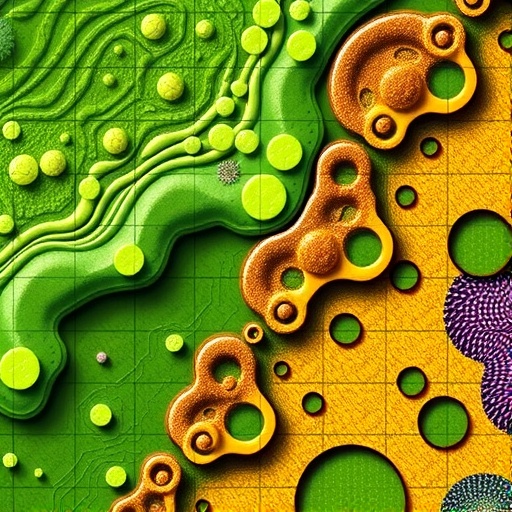In recent years, the intricate web of microbial nitrogen cycling has gained renewed scientific attention, driving a surge of research that seeks to decode the complexities of this vital biochemical network. The nitrogen cycle, fundamental to global ecosystem functioning, governs the transformation and movement of nitrogenous compounds through the atmosphere, biosphere, and lithosphere. However, unraveling its microbial underpinnings, particularly in the face of anthropogenic changes and environmental stressors, remains a formidable challenge. A groundbreaking bibliometric study led by Gui, Wang, Qin, and colleagues, published in Environmental Earth Sciences, revisits this microbial nitrogen-cycling network, offering fresh insights bolstered by an extensive quantitative analysis of the field’s evolving landscape and highlighting the latest advances in microbial ecology and environmental microbiology.
This comprehensive review articulates the dynamic interplay of microorganisms that drive nitrogen transformations including nitrification, denitrification, anammox (anaerobic ammonium oxidation), nitrogen fixation, and ammonification. By deploying bibliometric tools, the authors trace the trajectory of scientific focus, revealing prolific research clusters and emerging hotspots that map onto pivotal advances in genetics, metagenomics, and systems biology approaches. This meta-analytical perspective dispels prior oversimplifications of microbial nitrogen cycling and emphasizes the nuanced roles of microbial consortia across diverse habitats ranging from soils and freshwater sediments to marine environments and engineered bioreactors.
One of the key revelations illuminated by their bibliometric mapping is the paradigm shift toward recognizing the unprecedented diversity and functional plasticity within nitrogen-transforming microbial communities. Traditional models often hinged on a small cadre of well-characterized species, but recent -omics technologies have unmasked a multitude of novel taxa and metabolic pathways. These discoveries recalibrate long-standing nitrogen budgets and challenge existing ecological models, underscoring the need for integrative frameworks that incorporate microbial ecology at multiple spatiotemporal scales.
A particularly thrilling frontier unveiled by this review is the role of comammox (complete ammonia oxidizers) bacteria, which perform the entire oxidation of ammonia to nitrate within a single organism—contrasting with the conventional two-step nitrification process partitioned between ammonia-oxidizing and nitrite-oxidizing microbes. These comammox organisms exemplify the functional innovation within nitrogen cycling and open new avenues for biogeochemical and applied research, especially in wastewater treatment where nitrogen removal efficiency is paramount.
The study also places a spotlight on the anaerobic ammonium oxidation (anammox) process, discovered only a few decades ago but already reshaping our understanding of nitrogen loss in anoxic environments. This microbial pathway crucially contributes to the removal of fixed nitrogen from aquatic systems, thereby influencing marine productivity and greenhouse gas emissions. The bibliometric analysis tracks the exponential growth in anammox research, propelled by advances in molecular markers and environmental sampling technologies, illustrating the community’s impact beyond academic circles into practical environmental management.
Another critical dimension addressed in this review is the influence of environmental change, including pollution, land-use alterations, and climate warming, on microbial nitrogen cycling networks. By synthesizing current findings, the authors reveal how shifts in temperature, moisture regimes, and chemical inputs disrupt microbial community structure and function. Such perturbations reverberate through nitrogen transformations, modulating ecosystem fertility and greenhouse gas fluxes, thereby linking microbial nitrogen cycling to global sustainability concerns and climate feedback loops.
In addition, this bibliometric approach highlights gaps in geographic and ecosystem coverage, drawing attention to underexplored environments such as deep subsurface biospheres and extreme habitats. These niches harbor microbial assemblages with unique enzymatic capabilities that could redefine the global nitrogen budget and inspire bioengineering innovations. The authors advocate for enhanced interdisciplinary collaborations merging microbiology, geochemistry, and environmental engineering to better contextualize microbial nitrogen cycling within Earth system science.
Cutting-edge methodological strides also permeate this review, particularly the rise of high-throughput sequencing, metatranscriptomics, and isotope tracing techniques which collectively enable in situ characterization of microbial function and nitrogen fluxes with unprecedented resolution. Such technological advancements empower scientists to delineate active metabolic pathways and decipher microbe-microbe and microbe-environment interactions in complex communities.
Furthermore, the bibliometric data reveals a competitive yet interconnected scientific community, with influential laboratories and countries driving research frontiers. This social network dynamics underscores the global recognition of microbial nitrogen cycling as a cornerstone of environmental science and a critical leverage point for mitigating anthropogenic impacts on ecosystems.
The paper additionally touches on the implications of microbial nitrogen cycling knowledge for policy and environmental management. Understanding nitrogen flows at the microbial scale is central to devising strategies for nutrient management in agriculture, combating eutrophication in aquatic ecosystems, and curbing emissions of nitrous oxide, a potent greenhouse gas.
Through this meticulous review, Gui and colleagues set the stage for a new epoch of nitrogen cycle research that integrates molecular insights with ecosystem-scale processes. They emphasize that only by embracing the complexity of microbial networks and their environmental contexts can we progress toward predictive models that inform sustainable stewardship of global nitrogen resources.
The articulation of microbial nitrogen cycling as a pivotal element in Earth system functioning recasts microbes not merely as passive participants but as active engineers shaping planetary biogeochemistry. This concept reiterates the fundamental link between microscopic life and macroscopic environmental phenomena, a relationship that is poised to deepen our understanding of biosphere resilience in an era of rapid environmental change.
In conclusion, this bibliometric and scientific synthesis heralds microbial nitrogen cycling as a vibrant, fast-evolving discipline at the nexus of microbiology, ecology, and environmental earth sciences. The reviewed trends and technological innovations underscore the immense potential of this research domain to not only elucidate fundamental biological processes but also to drive solutions for environmental sustainability and climate mitigation. As researchers worldwide harness new tools and interdisciplinary perspectives, the microbial nitrogen-cycling network will continue to reveal its complexity and crucial role in maintaining life on Earth.
Subject of Research: Microbial nitrogen-cycling networks and their ecological and environmental significance.
Article Title: Revisiting the microbial nitrogen-cycling network: bibliometric analysis and recent advances.
Article References:
Gui, X., Wang, W., Qin, D. et al. Revisiting the microbial nitrogen-cycling network: bibliometric analysis and recent advances. Environ Earth Sci 84, 484 (2025). https://doi.org/10.1007/s12665-025-12481-0
Image Credits: AI Generated




